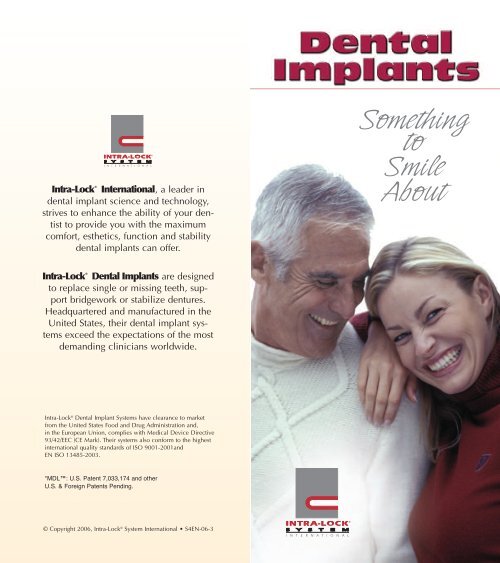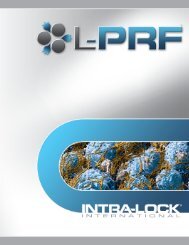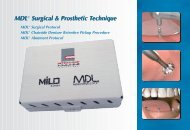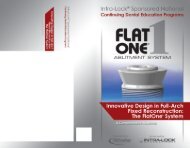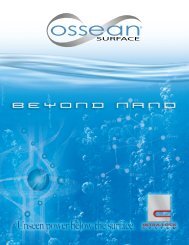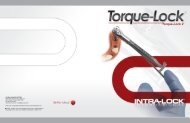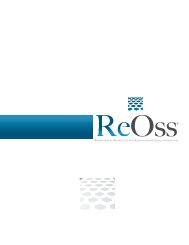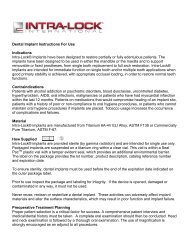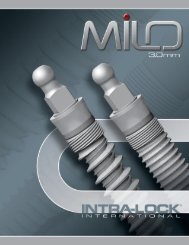Something to Smile About - Intra-Lock
Something to Smile About - Intra-Lock
Something to Smile About - Intra-Lock
You also want an ePaper? Increase the reach of your titles
YUMPU automatically turns print PDFs into web optimized ePapers that Google loves.
<strong>Intra</strong>-<strong>Lock</strong> ® International, a leader in<br />
dental implant science and technology,<br />
strives <strong>to</strong> enhance the ability of your dentist<br />
<strong>to</strong> provide you with the maximum<br />
comfort, esthetics, function and stability<br />
dental implants can offer.<br />
<strong>Intra</strong>-<strong>Lock</strong> ® Dental Implants are designed<br />
<strong>to</strong> replace single or missing teeth, support<br />
bridgework or stabilize dentures.<br />
Headquartered and manufactured in the<br />
United States, their dental implant systems<br />
exceed the expectations of the most<br />
demanding clinicians worldwide.<br />
<strong>Intra</strong>-<strong>Lock</strong> ® Dental Implant Systems have clearance <strong>to</strong> market<br />
from the United States Food and Drug Administration and,<br />
in the European Union, complies with Medical Device Directive<br />
93/42/EEC (CE Mark). Their systems also conform <strong>to</strong> the highest<br />
international quality standards of ISO 9001-2001and<br />
EN ISO 13485-2003.<br />
*MDL: U.S. Patent 7,033,174 and other<br />
U.S. & Foreign Patents Pending.<br />
© Copyright 2006, <strong>Intra</strong>-<strong>Lock</strong> ® System International • S4EN-06-3<br />
<strong>Something</strong><br />
<strong>to</strong><br />
<strong>Smile</strong><br />
<strong>About</strong>
Missing teeth or loose dentures<br />
are problems of the past thanks<br />
<strong>to</strong> dental implants. Today, the art and science<br />
of placing dental implants has<br />
become a routine res<strong>to</strong>rative procedure<br />
in many dental offices around the world.<br />
Dental implants are an outgrowth of the<br />
same discipline of orthopedic medicine<br />
that brought you titanium hips and knee<br />
replacements. In dentistry, implants are<br />
titanium substitutes for the roots of teeth.<br />
Once in place, they become firmly<br />
attached <strong>to</strong> the bone in a process that is<br />
called osseointegration. An artificial<br />
<strong>to</strong>oth or denture is then attached <strong>to</strong><br />
the implant.<br />
Implant<br />
=<br />
} Tooth<br />
Root
Who can benefit from dental implants?<br />
Anyone with missing teeth.<br />
How do dental implants differ from conventional<br />
bridges?<br />
Conventional “bridges” involve the preparation<br />
of teeth on either side of the missing<br />
<strong>to</strong>oth area and three crowns are needed in<br />
order <strong>to</strong> make a bridge that replaces one<br />
missing <strong>to</strong>oth!<br />
Unlike conventional bridges, dental<br />
implants can be used <strong>to</strong> replace single or<br />
multiple missing teeth without ever affecting<br />
your natural teeth.<br />
Dental implants are also of great help <strong>to</strong><br />
people who wear dentures by affording<br />
security and stability previously unimaginable.
Are there different types of<br />
dental implants?<br />
Yes. A variety of sizes, shapes and configurations<br />
are necessary because of the<br />
wide range of ana<strong>to</strong>mical differences<br />
such as the amount of bone, bone quality<br />
and the shape and relationship of the<br />
upper and lower jaws. Your dentist will<br />
prescribe the appropriate implant for your<br />
specific needs.<br />
How do implants replace natural teeth?<br />
Fixed or permanent dental implant<br />
res<strong>to</strong>rations are crowns and bridges that<br />
are fabricated on <strong>to</strong>p of dental implants<br />
and most closely resemble the look,<br />
feel and function of natural teeth. An<br />
appropriate amount of dental implants<br />
are surgically placed and, upon osseointegration,<br />
the teeth are res<strong>to</strong>red with individual<br />
crowns and/or fixed bridgework.<br />
How long is the healing period?<br />
Prosthetic<br />
Tooth<br />
Implant<br />
Healing times vary, but if your dentist<br />
feels a more extensive healing period is<br />
warranted, a transitional or temporary<br />
res<strong>to</strong>ration may be suggested. A temporary<br />
<strong>to</strong>oth or bridge allows you <strong>to</strong> have esthetics<br />
and function immediately.<br />
The denture is<br />
then secured<br />
by snapping<br />
it in<strong>to</strong> place.<br />
Denture<br />
Retentive<br />
Cap<br />
*MDL <br />
Mini Implant<br />
Can implants be used in conjunction<br />
with my dentures?<br />
Definitely!<br />
Implants have been a tremendous help for<br />
patients who wear dentures.<br />
Implants can assist in stabilizing dentures<br />
by converting them in<strong>to</strong> “overdentures”,<br />
making them solid, secure and functional.<br />
This solution works well for patients who<br />
are not clinical candidates for full-mouth<br />
dental implant reconstruction, or who seek<br />
a more cost-effective alternative.<br />
The need for dental creams and powders<br />
is eliminated. Dentures simply snap<br />
in<strong>to</strong> place.<br />
Life-changing technology.<br />
<strong>Smile</strong> with confidence. Ask your dentist<br />
how <strong>Intra</strong>-<strong>Lock</strong> ® dental implant systems<br />
can help you <strong>to</strong> experience a whole<br />
new world of comfort, conversation<br />
and dining.


